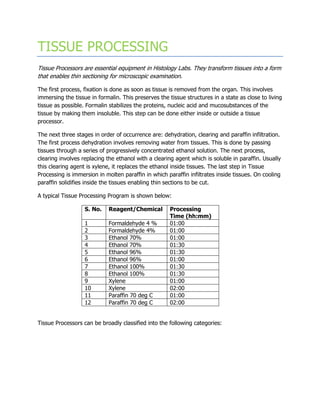Tissue processing
- 1. TISSUE PROCESSING Tissue Processors are essential equipment in Histology Labs. They transform tissues into a form that enables thin sectioning for microscopic examination. The first process, fixation is done as soon as tissue is removed from the organ. This involves immersing the tissue in formalin. This preserves the tissue structures in a state as close to living tissue as possible. Formalin stabilizes the proteins, nucleic acid and mucosubstances of the tissue by making them insoluble. This step can be done either inside or outside a tissue processor. The next three stages in order of occurrence are: dehydration, clearing and paraffin infiltration. The first process dehydration involves removing water from tissues. This is done by passing tissues through a series of progressively concentrated ethanol solution. The next process, clearing involves replacing the ethanol with a clearing agent which is soluble in paraffin. Usually this clearing agent is xylene, it replaces the ethanol inside tissues. The last step in Tissue Processing is immersion in molten paraffin in which paraffin infiltrates inside tissues. On cooling paraffin solidifies inside the tissues enabling thin sections to be cut. A typical Tissue Processing Program is shown below: S. No. Reagent/Chemical Processing Time (hh:mm) 1 Formaldehyde 4 % 01:00 2 Formaldehyde 4% 01:00 3 Ethanol 70% 01:00 4 Ethanol 70% 01:30 5 Ethanol 96% 01:30 6 Ethanol 96% 01:00 7 Ethanol 100% 01:30 8 Ethanol 100% 01:30 9 Xylene 01:00 10 Xylene 02:00 11 Paraffin 70 deg C 01:00 12 Paraffin 70 deg C 02:00 Tissue Processors can be broadly classified into the following categories:
- 2. TISSUE PROCESSORS MOVING MOVING TISSUE TYPE REAGENT TYPE MTP-VT CAROUSEL TYPE LINEAR TYPE MTP-M SERIES MTP-AT &E SERIES In Moving Tissue Type Tissue Processors the reagent is stationary and the tissues are moved from one reagent to the next, on the other hand in Moving Reagent Type Tissue Processors the tissues are stationary and the reagent is circulated, one after another, in the processing retort. Moving Tissue Type- Moving Tissue Type- Moving Reagent Type- Carousel-Tissue Processor Linear-Tissue Processor Tissue Processor ÂĐ 2012 Medimeas Instruments


